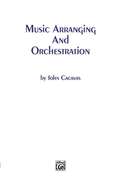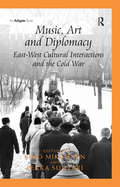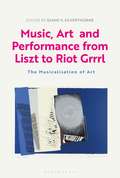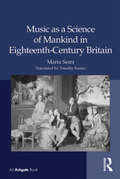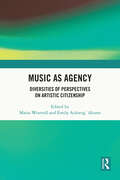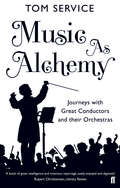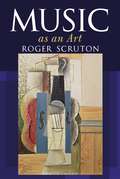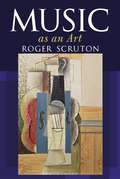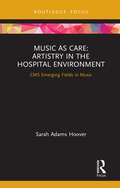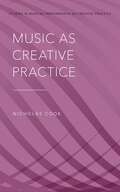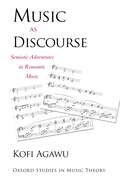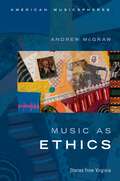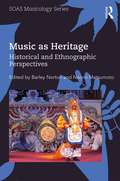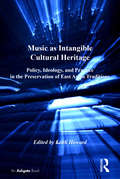- Table View
- List View
Music Arranging And Orchestration
by John CacavasOrchestrating is a highly complex technique and to many, even those with academic training, a mystery fraught with a labyrinth of hazards. What is required, along with innate talent and general musicality, is the practical "know how." This is hard to achieve without actual professional experience and contact with "live" orchestras. To this end, John Cacavas contributes his extensive experience and ability with a practical approach to the practical problems of orchestrating. It is in this context most orchestrators must function, and to whom this book should be of benefit. The author has been a "musical activist" in all the varied aspects of instrumental combination from the "classical" to the "contemporary," and in the diverse application of his skills in all the media that utilize music and "orchestrations."
Music, Art and Diplomacy: East-west Cultural Interactions And The Cold War
by Simo Mikkonen Pekka SuutariMusic, Art and Diplomacy shows how a vibrant field of cultural exchange between East and West was taking place during the Cold War, which contrasts with the orthodox understanding of two divided and antithetical blocs. The series of case studies on cultural exchanges, focusing on the decades following the Second World War, cover episodes involving art, classical music, theatre, dance and film. Despite the fluctuating fortunes of diplomatic relations between East and West, there was a continuous circulation of cultural producers and products. Contributors explore the interaction of arts and politics, the role of the arts in diplomacy and the part the arts played in the development of the Cold War. Art has always shunned political borders, wavering between the guidance of individual and governmental patrons, and borderless expression. While this volume provides insight into how political players tried to harness the arts to serve their own political purposes, at the same time it is clear that the arts and artists exploited the Cold War framework to reach their own individual and professional objectives. Utilizing archives available only since the collapse of the Soviet Union, the volume provides a valuable socio-cultural approach to understanding the Cold War and cultural diplomacy.
Music, Art and Diplomacy: East-West Cultural Interactions and the Cold War
by Simo Mikkonen Pekka SuutariMusic, Art and Diplomacy shows how a vibrant field of cultural exchange between East and West was taking place during the Cold War, which contrasts with the orthodox understanding of two divided and antithetical blocs. The series of case studies on cultural exchanges, focusing on the decades following the Second World War, cover episodes involving art, classical music, theatre, dance and film. Despite the fluctuating fortunes of diplomatic relations between East and West, there was a continuous circulation of cultural producers and products. Contributors explore the interaction of arts and politics, the role of the arts in diplomacy and the part the arts played in the development of the Cold War. Art has always shunned political borders, wavering between the guidance of individual and governmental patrons, and borderless expression. While this volume provides insight into how political players tried to harness the arts to serve their own political purposes, at the same time it is clear that the arts and artists exploited the Cold War framework to reach their own individual and professional objectives. Utilizing archives available only since the collapse of the Soviet Union, the volume provides a valuable socio-cultural approach to understanding the Cold War and cultural diplomacy.
Music, Art and Performance from Liszt to Riot Grrrl: The Musicalization of Art
by Diane V. SilverthorneOpening with an account of print portraiture facilitating Franz Liszt's celebrity status and concluding with Riot Grrrl's noisy politics of feminism and performance, this interdisciplinary anthology charts the relationship between music and the visual arts from late Romanticism and the birth of modernism to 'postmodernism', while crossing from Western art to the Middle East. Focused on music as a central experience of art and life, these essays scrutinize 'the musicalisation of art' focusing on the visual and performing arts and detailing significant instances of intra-art relations between c. 1840 and the present day. Essays reflect on the aesthetic relationships of music to painting, performance and installation, sound-and- silence, time-and-space. The insistent influence of Wagner is considered as well as the work and ideas of Manet, Satie and Cage, Thomas Wilfred, La Monte Young and Eliasson. What distinguishes these studies are the convictions that music is never alone and that a full understanding of the “isms” of the last two hundred years is best achieved when music's influential presence in the visual arts is acknowledged and interrogated.
Music, Art and Performance from Liszt to Riot Grrrl: The Musicalization of Art (Criminal Practice Ser.)
by Diane V. SilverthorneOpening with an account of print portraiture facilitating Franz Liszt's celebrity status and concluding with Riot Grrrl's noisy politics of feminism and performance, this interdisciplinary anthology charts the relationship between music and the visual arts from late Romanticism and the birth of modernism to 'postmodernism', while crossing from Western art to the Middle East. Focused on music as a central experience of art and life, these essays scrutinize 'the musicalisation of art' focusing on the visual and performing arts and detailing significant instances of intra-art relations between c. 1840 and the present day. Essays reflect on the aesthetic relationships of music to painting, performance and installation, sound-and- silence, time-and-space. The insistent influence of Wagner is considered as well as the work and ideas of Manet, Satie and Cage, Thomas Wilfred, La Monte Young and Eliasson. What distinguishes these studies are the convictions that music is never alone and that a full understanding of the “isms” of the last two hundred years is best achieved when music's influential presence in the visual arts is acknowledged and interrogated.
Music as a Science of Mankind in Eighteenth-Century Britain
by Maria Semi translated by KeatesMusic as a Science of Mankind offers a philosophical and historical perspective on the intellectual representation of music in British eighteenth-century culture. From the field of natural philosophy, involving the science of sounds and acoustics, to the realm of imagination, involving resounding music and art, the branches of modern culture that were involved in the intellectual tradition of the science of music proved to be variously appealing to men of letters. Among these, a particularly rich field of investigation was the British philosophy of the mind and of human understanding, developed between the seventeenth and eighteenth centuries, which looked at music and found in its realm a way of understanding human experience. Focussing on the world of sensation - trying to describe how the human mind could develop ideas and emotions by its means - philosophers and physicians often took their cases from art's products, be it music (sounds), painting (colours) or poetry (words as signs of sound conveying a meaning), thus looking at art from a particular point of view: that of the perceiving mind. The relationship between music and the philosophies of mind is presented here as a significant part of the construction of a Science of Man: a huge and impressive 'project' involving both the study of man's nature, to which - in David Hume's words - 'all sciences have a relation', and the creation of an ideal of what Man should be. Maria Semi sheds light on how these reflections moved towards a Science of Music: a complex and articulated vision of the discipline that was later to be known as 'musicology'; or Musikwissenschaft.
Music as a Science of Mankind in Eighteenth-Century Britain
by Maria Semi translated by KeatesMusic as a Science of Mankind offers a philosophical and historical perspective on the intellectual representation of music in British eighteenth-century culture. From the field of natural philosophy, involving the science of sounds and acoustics, to the realm of imagination, involving resounding music and art, the branches of modern culture that were involved in the intellectual tradition of the science of music proved to be variously appealing to men of letters. Among these, a particularly rich field of investigation was the British philosophy of the mind and of human understanding, developed between the seventeenth and eighteenth centuries, which looked at music and found in its realm a way of understanding human experience. Focussing on the world of sensation - trying to describe how the human mind could develop ideas and emotions by its means - philosophers and physicians often took their cases from art's products, be it music (sounds), painting (colours) or poetry (words as signs of sound conveying a meaning), thus looking at art from a particular point of view: that of the perceiving mind. The relationship between music and the philosophies of mind is presented here as a significant part of the construction of a Science of Man: a huge and impressive 'project' involving both the study of man's nature, to which - in David Hume's words - 'all sciences have a relation', and the creation of an ideal of what Man should be. Maria Semi sheds light on how these reflections moved towards a Science of Music: a complex and articulated vision of the discipline that was later to be known as 'musicology'; or Musikwissenschaft.
Music as Agency: Diversities of Perspectives on Artistic Citizenship
by Maria Westvall Emily Achieng’ AkunoMusic as Agency: Diversities of Perspectives on Artistic Citizenship focuses on the concept, application, interpretation and manifestation of Artistic Citizenship in diverse contexts. The key concepts that the book tackles are: Cultural experience, artistic practice, musical identities, equity, democracy, community, activism, resistance and empathy.In giving an overview of aspects of the compound concept of artistic citizenship, Akuno and Westvall present the outcome of research and interrogation of practice by a global network of educator-researchers from Africa, the Americas, Asia and Europe. The book articulates notions of artistic citizenship, coming up with the term artizenship as a derivative of the composite term. It further explains and analyses practical ways of perceiving and relating to art spaces, art practices and arts objects towards belonging, being and becoming in a global space that is disparate, polarised and often alienating, and thus responding to issues such as social justice, identity, participation and inclusion. With a focus on music, the book targets musicians, scholars, educators and enthusiasts keen on gaining a deeper understanding of how music and musicking can influence human interactions towards social integration, trust, cultural awareness and intercultural understanding.
Music as Agency: Diversities of Perspectives on Artistic Citizenship
Music as Agency: Diversities of Perspectives on Artistic Citizenship focuses on the concept, application, interpretation and manifestation of Artistic Citizenship in diverse contexts. The key concepts that the book tackles are: Cultural experience, artistic practice, musical identities, equity, democracy, community, activism, resistance and empathy.In giving an overview of aspects of the compound concept of artistic citizenship, Akuno and Westvall present the outcome of research and interrogation of practice by a global network of educator-researchers from Africa, the Americas, Asia and Europe. The book articulates notions of artistic citizenship, coming up with the term artizenship as a derivative of the composite term. It further explains and analyses practical ways of perceiving and relating to art spaces, art practices and arts objects towards belonging, being and becoming in a global space that is disparate, polarised and often alienating, and thus responding to issues such as social justice, identity, participation and inclusion. With a focus on music, the book targets musicians, scholars, educators and enthusiasts keen on gaining a deeper understanding of how music and musicking can influence human interactions towards social integration, trust, cultural awareness and intercultural understanding.
Music as Alchemy: Journeys with Great Conductors and their Orchestras
by Tom ServiceHow are conductors' silent gestures magicked into sound by a group of more than a hundred brilliant but belligerent musicians? The mute choreography of great conductors has fascinated and frustrated musicians and music-lovers for centuries. Orchestras can be inspired to the heights of musical and expressive possibility by their maestros, or flabbergasted that someone who doesn't even make a sound should be elevated to demigod-like status by the public.This is the first book to go inside the rehearsal rooms of some of the most inspirational orchestral partnerships in the world - how Simon Rattle works at the Berlin Philharmonic, how Mariss Jansons deals with the Concertgebouw Orchestra in Amsterdam, and how Claudio Abbado creates the world's most luxurious pick-up band every year with the Lucerne Festival Orchestra. From London to Budapest, Bamberg to Vienna, great orchestral concerts are recreated as a collection of countless human and musical stories.
Music as an Art
by Roger ScrutonMusic as an Art begins by examining music through a philosophical lens, engaging in discussions about tonality, music and the moral life, music and cognitive science and German idealism, as well as recalling the author's struggle to encourage his students to distinguish the qualities of good music. Scruton then explains – via erudite chapters on Schubert, Britten, Rameau, opera and film – how we can develop greater judgement in music, recognising both good taste and bad, establishing musical values, as well as musical pleasures.As Scruton argues in this book, in earlier times, our musical culture had secure foundations in the church, the concert hall and the home; in the ceremonies and celebrations of ordinary life, religion and manners. Yet we no longer live in that world. Fewer people now play instruments and music is, for many, a form of largely solitary enjoyment. As he shows in Music as an Art, we live at a critical time for classical music, and this book is an important contribution to the debate, of which we stand in need, concerning the place of music in Western civilization.
Music as an Art
by Sir Roger ScrutonMusic as an Art begins by examining music through a philosophical lens, engaging in discussions about tonality, music and the moral life, music and cognitive science and German idealism, as well as recalling the author's struggle to encourage his students to distinguish the qualities of good music. Scruton then explains – via erudite chapters on Schubert, Britten, Rameau, opera and film – how we can develop greater judgement in music, recognising both good taste and bad, establishing musical values, as well as musical pleasures.As Scruton argues in this book, in earlier times, our musical culture had secure foundations in the church, the concert hall and the home; in the ceremonies and celebrations of ordinary life, religion and manners. Yet we no longer live in that world. Fewer people now play instruments and music is, for many, a form of largely solitary enjoyment. As he shows in Music as an Art, we live at a critical time for classical music, and this book is an important contribution to the debate, of which we stand in need, concerning the place of music in Western civilization.
Music as Biology: The Tones We Like And Why
by Dale PurvesWhy do human beings find some tone combinations consonant and others dissonant? Why do we make music using only a small number of scales out the billions that are possible? Dale Purves shows that rethinking music theory in biological terms offers a new approach to centuries-long debates about the organization and impact of music.
Music as Care: CMS Emerging Fields in Music (CMS Emerging Fields in Music)
by Sarah Adams HooverThis book provides an overview of professional musicians working within the healthcare system and explores programs that bring music into the environment of the hospital. Far from being onstage, musicians in the hospital provide musical engagement for patients and healthcare providers focused on life-and-death issues. Music in healthcare offers a new and growing area for musical careers, distinct from the field of music therapy in which music is engaged to advance defined clinical goals. Rather, this volume considers what happens when musicians interact with the clinical environment as artists, and how musical careers and artistic practices can develop through work in a hospital setting. It outlines the specialized skills and training required to navigate safely and effectively within the healthcare context. The contributors draw on their experiences with collaborations between the performing arts and medicine at Boston University/Boston Medical Center, University of Florida/UF Health Shands Hospital, and the Peabody Institute/Johns Hopkins Medicine. These experiences, as well as the experiences of artists spotlighted throughout the volume, offer stories of thriving artistic practices and collaborations that outline a new field for tomorrow's musical artists.
Music as Care: CMS Emerging Fields in Music (CMS Emerging Fields in Music)
by Sarah Adams HooverThis book provides an overview of professional musicians working within the healthcare system and explores programs that bring music into the environment of the hospital. Far from being onstage, musicians in the hospital provide musical engagement for patients and healthcare providers focused on life-and-death issues. Music in healthcare offers a new and growing area for musical careers, distinct from the field of music therapy in which music is engaged to advance defined clinical goals. Rather, this volume considers what happens when musicians interact with the clinical environment as artists, and how musical careers and artistic practices can develop through work in a hospital setting. It outlines the specialized skills and training required to navigate safely and effectively within the healthcare context. The contributors draw on their experiences with collaborations between the performing arts and medicine at Boston University/Boston Medical Center, University of Florida/UF Health Shands Hospital, and the Peabody Institute/Johns Hopkins Medicine. These experiences, as well as the experiences of artists spotlighted throughout the volume, offer stories of thriving artistic practices and collaborations that outline a new field for tomorrow's musical artists.
Music as Creative Practice (Studies in Musical Perf as Creative Prac)
by Nicholas CookUntil recently, ideas of creativity in music revolved around composers in garrets and the lone genius. But the last decade has witnessed a sea change: musical creativity is now overwhelmingly thought of in terms of collaboration and real-time performance. Music as Creative Practice is a first attempt to synthesize both perspectives. It begins by developing the idea that creativity arises out of social interaction-of which making music together is perhaps the clearest possible illustration-and then shows how the same thinking can be applied to the ostensively solitary practices of composition. The book also emphasizes the contextual dimensions of musical creativity, ranging from the prodigy phenomenon, long-term collaborative relationships within and beyond the family, and creative learning to the copyright system that is supposed to incentivize creativity but is widely seen as inhibiting it. Music as Creative Practice encompasses the classical tradition, jazz and popular music, and music emerges as an arena in which changing concepts of creativity-from the old myths about genius to present-day sociocultural theory-can be traced with particular clarity. The perspective of creativity tells us much about music, but the reverse is also true, and this fifth and last instalment of the Studies in Musical Performance as Creative Practice series offers an approach to musical creativity that is attuned to the practices of both music and everyday life.
Music as Creative Practice (Studies in Musical Perf as Creative Prac)
by Nicholas CookUntil recently, ideas of creativity in music revolved around composers in garrets and the lone genius. But the last decade has witnessed a sea change: musical creativity is now overwhelmingly thought of in terms of collaboration and real-time performance. Music as Creative Practice is a first attempt to synthesize both perspectives. It begins by developing the idea that creativity arises out of social interaction-of which making music together is perhaps the clearest possible illustration-and then shows how the same thinking can be applied to the ostensively solitary practices of composition. The book also emphasizes the contextual dimensions of musical creativity, ranging from the prodigy phenomenon, long-term collaborative relationships within and beyond the family, and creative learning to the copyright system that is supposed to incentivize creativity but is widely seen as inhibiting it. Music as Creative Practice encompasses the classical tradition, jazz and popular music, and music emerges as an arena in which changing concepts of creativity-from the old myths about genius to present-day sociocultural theory-can be traced with particular clarity. The perspective of creativity tells us much about music, but the reverse is also true, and this fifth and last instalment of the Studies in Musical Performance as Creative Practice series offers an approach to musical creativity that is attuned to the practices of both music and everyday life.
Music as Discourse: Semiotic Adventures in Romantic Music (Oxford Studies in Music Theory)
by Kofi AgawuThe question of whether music has meaning has been the subject of sustained debate ever since music became a subject of academic inquiry. Is music a language? Does it communicate specific ideas and emotions? What does music mean, and how does this meaning occur? Kofi Agawu's Music as Discourse has become a standard and definitive work in musical semiotics. Working at the nexus of musicology, ethnomusicology, and music philosophy and aesthetics, Agawu presents a synthetic and innovative approach to musical meaning which argues deftly for the thinking of music as a discourse in itself--composed not only of sequences of gestures, phrases, or progressions, but rather also of the very philosophical and linguistic props that enable the analytical formulations made about music as an object of study. The book provides extensive demonstration of the pertinence of a semiological approach to understanding the fully-freighted language of romantic music, stresses the importance of a generative approach to tonal understanding, and provides further insight into the analogy between music and language. Music as Discourse is an essential read for all who are interested in the theory, analysis and semiotics of music of the romantic period.
Music as Discourse: Semiotic Adventures in Romantic Music (Oxford Studies in Music Theory)
by Kofi AgawuThe question of whether music has meaning has been the subject of sustained debate ever since music became a subject of academic inquiry. Is music a language? Does it communicate specific ideas and emotions? What does music mean, and how does this meaning occur? Kofi Agawu's Music as Discourse has become a standard and definitive work in musical semiotics. Working at the nexus of musicology, ethnomusicology, and music philosophy and aesthetics, Agawu presents a synthetic and innovative approach to musical meaning which argues deftly for the thinking of music as a discourse in itself--composed not only of sequences of gestures, phrases, or progressions, but rather also of the very philosophical and linguistic props that enable the analytical formulations made about music as an object of study. The book provides extensive demonstration of the pertinence of a semiological approach to understanding the fully-freighted language of romantic music, stresses the importance of a generative approach to tonal understanding, and provides further insight into the analogy between music and language. Music as Discourse is an essential read for all who are interested in the theory, analysis and semiotics of music of the romantic period.
Music as Ethics: Stories from Virginia (AMERICAN MUSICSPHERES SERIES)
by Andrew McGrawMusic as Ethics offers a comparative ethnography of the relationship of music to ethics in four communities in Virginia, covering a wide range of demographic contexts and musical repertoires. Holy Cross Monastery in Berryville is a small community of fifteen Trappist monks who follow the rule of St. Benedict, composed in the early sixth century. Twin Oaks in Louisa is a ninety-member intentional community, founded in 1967, dedicated to egalitarianism. The "Sanctuary" in the Richmond city jail is a community of approximately forty residents drawn from two of the facility's dorms. Richmond is the state capital, with a fraught history of racial inequality. To say that we can experience music "as" ethics means that we can hold several, culturally informed attitudes about music's ethical meanings and functions. While music's relationship to ethical life differs between each community, the case studies suggest that we can all grow as ethical individuals and communities if we pay close attention to music's ethical potential. But as long as our experience of music as ethics remains implicit and vague, we miss an opportunity to fully realize its ethical affordances. More than that, we also expose ourselves to manipulation by those who would wield music (and other "affective" means) for their own social agenda.
Music as Ethics: Stories from Virginia (AMERICAN MUSICSPHERES SERIES)
by Andrew McGrawMusic as Ethics offers a comparative ethnography of the relationship of music to ethics in four communities in Virginia, covering a wide range of demographic contexts and musical repertoires. Holy Cross Monastery in Berryville is a small community of fifteen Trappist monks who follow the rule of St. Benedict, composed in the early sixth century. Twin Oaks in Louisa is a ninety-member intentional community, founded in 1967, dedicated to egalitarianism. The "Sanctuary" in the Richmond city jail is a community of approximately forty residents drawn from two of the facility's dorms. Richmond is the state capital, with a fraught history of racial inequality. To say that we can experience music "as" ethics means that we can hold several, culturally informed attitudes about music's ethical meanings and functions. While music's relationship to ethical life differs between each community, the case studies suggest that we can all grow as ethical individuals and communities if we pay close attention to music's ethical potential. But as long as our experience of music as ethics remains implicit and vague, we miss an opportunity to fully realize its ethical affordances. More than that, we also expose ourselves to manipulation by those who would wield music (and other "affective" means) for their own social agenda.
Music as Heritage: Historical and Ethnographic Perspectives (SOAS Studies in Music Series)
by Barley Norton Naomi MatsumotoAs economic, technological and cultural change gathers pace across the world, issues of music heritage and sustainability have become ever more pressing. Discourse on intangible cultural heritage has developed in complex ways in recent years, and musical practices have been transformed by safeguarding agendas. Music as Heritage takes stock of these transformations, bringing new ethnographic and historical perspectives to bear on our encounters with music heritage. The volume evaluates the cultural politics, ethics and audiovisual representation of music heritage; the methods and consequences of music transmission across national borders; and the perennial issues of revival, change and innovation. UNESCO’s 2003 Convention for the Safeguarding of the Intangible Cultural Heritage provides an essential reference point for studies of music heritage. However, this volume also pays attention to important spheres of musical activity that lie outside of UNESCO’s reach and the reasons why some repertories of music are chosen for safeguarding while others are not. Some practices of art music in Europe explored in this book, for example, have received little attention despite being susceptible to endangerment. Developing a comparative framework that cuts across genre distinctions and disciplinary boundaries, Music as Heritage explores how music cultures are being affected by heritage discourse and the impact of international and national policies on grass-roots music practices.
Music as Heritage: Historical and Ethnographic Perspectives (SOAS Studies in Music Series)
by Barley Norton Naomi MatsumotoAs economic, technological and cultural change gathers pace across the world, issues of music heritage and sustainability have become ever more pressing. Discourse on intangible cultural heritage has developed in complex ways in recent years, and musical practices have been transformed by safeguarding agendas. Music as Heritage takes stock of these transformations, bringing new ethnographic and historical perspectives to bear on our encounters with music heritage. The volume evaluates the cultural politics, ethics and audiovisual representation of music heritage; the methods and consequences of music transmission across national borders; and the perennial issues of revival, change and innovation. UNESCO’s 2003 Convention for the Safeguarding of the Intangible Cultural Heritage provides an essential reference point for studies of music heritage. However, this volume also pays attention to important spheres of musical activity that lie outside of UNESCO’s reach and the reasons why some repertories of music are chosen for safeguarding while others are not. Some practices of art music in Europe explored in this book, for example, have received little attention despite being susceptible to endangerment. Developing a comparative framework that cuts across genre distinctions and disciplinary boundaries, Music as Heritage explores how music cultures are being affected by heritage discourse and the impact of international and national policies on grass-roots music practices.
Music as Intangible Cultural Heritage: Policy, Ideology, and Practice in the Preservation of East Asian Traditions (SOAS Studies in Music)
by Keith HowardFocussing on music traditions, these essays explore the policy, ideology and practice of preservation and promotion of East Asian intangible cultural heritage. For the first time, Japan, Korea, China and Taiwan - states that were amongst the first to establish legislation and systems for indigenous traditions - are considered together. Calls to preserve the intangible heritage have recently become louder, not least with increasing UNESCO attention. The imperative to preserve is, throughout the region, cast as a way to counter the perceived loss of cultural diversity caused by globalization, modernization, urbanization and the spread of the mass media. Four chapters - one each on China, Korea, Taiwan and Japan - incorporate a foundational overview of preservation policy and practice of musical intangible cultural heritage at the state level. These chapters are complemented by a set of chapters that explore how the practice of policy has impacted on specific musics, from Confucian ritual through Kam big song to the Okinawan sanshin. Each chapter is based on rich ethnographic data collected through extended fieldwork. The team of international contributors give both insider and outsider perspectives as they both account for, and critique, policy, ideology and practice in East Asian music as intangible cultural heritage.
Music as Intangible Cultural Heritage: Policy, Ideology, and Practice in the Preservation of East Asian Traditions (SOAS Studies in Music)
by Keith HowardFocussing on music traditions, these essays explore the policy, ideology and practice of preservation and promotion of East Asian intangible cultural heritage. For the first time, Japan, Korea, China and Taiwan - states that were amongst the first to establish legislation and systems for indigenous traditions - are considered together. Calls to preserve the intangible heritage have recently become louder, not least with increasing UNESCO attention. The imperative to preserve is, throughout the region, cast as a way to counter the perceived loss of cultural diversity caused by globalization, modernization, urbanization and the spread of the mass media. Four chapters - one each on China, Korea, Taiwan and Japan - incorporate a foundational overview of preservation policy and practice of musical intangible cultural heritage at the state level. These chapters are complemented by a set of chapters that explore how the practice of policy has impacted on specific musics, from Confucian ritual through Kam big song to the Okinawan sanshin. Each chapter is based on rich ethnographic data collected through extended fieldwork. The team of international contributors give both insider and outsider perspectives as they both account for, and critique, policy, ideology and practice in East Asian music as intangible cultural heritage.
